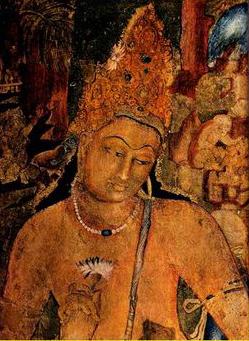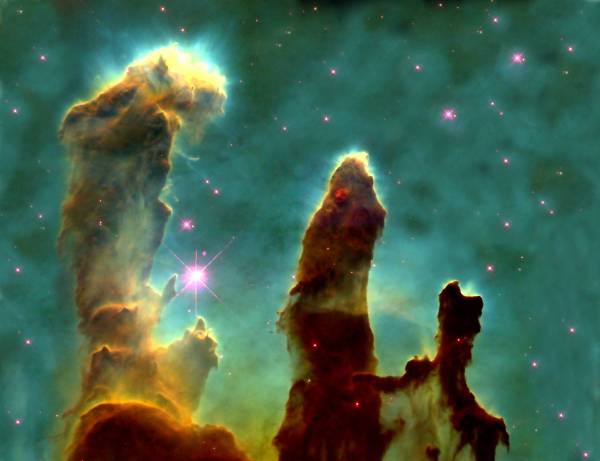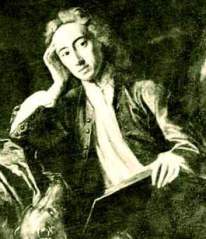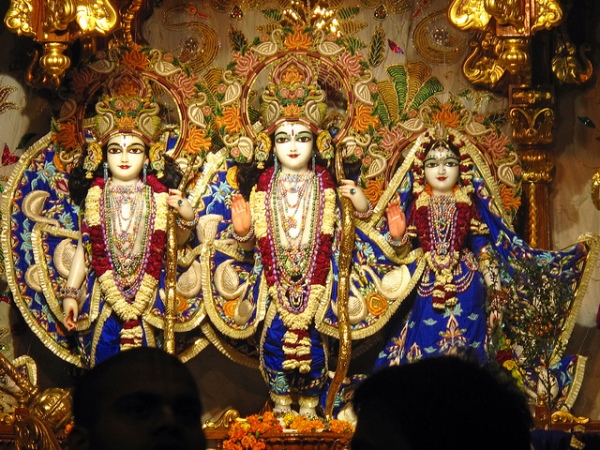Buddhist teachings and sermons were presented by Gautam Sakyamuni more as a therapy to heal the human condition than as a creed to explain and disseminate eternal metaphysical truths. Buddha the enlightened one, held that suffering was the ailment afflicting the human condition and the prime purpose of his teachings was to find a method and a way to alleviate and heal that condition. Anything that did not directly address this goal was not relevant to his concerns. The Buddha was not therefore interested in Metaphysical issues and refrained from commenting on them. Concepts such as God, Universal Spirit, Supersoul, an eternal universe, divinity and the nature of the Soul were therefore not commented upon. The Buddha implied to his disciples that discussion of such metaphysical questions ( aplenty at the time) did not in any way help in meeting his primary concern that of relieving mankind of its suffering and was therefore beyond the scope of his teachings. His only practical intent was to help people overcome their suffering rather than to propagate a grand creed or proselytize fundamental metaphysical truths. His teachings were also not intended for the disinterested masses but meant to help the few who genuinely desired to benefit from his methods to alleviate suffering. His sermons were therefore like a therapy only for the interested and he acted more like a physician than an apostle, concerned only with removing pain.
Thus emerge the Four Noble Truths: (1) All life is sorrowful and full of suffering. (2) The cause of suffering are ignorance (avidya) and desire (trishna) that follow from the fact that human existence is transitory and ephemeral. (3) the assertion that suffering can be removed. (4) The method of removing suffering and cessation of pain was the path to liberation – the Eight Fold Path : right view, intention, speech, action, livelihood, endeavour, mindfulness, and contemplation or meditation. The method was pragmatic and psychological with no philosophical explanation being provided about man and the universe. This method was also called the middle path, avoiding extremes of sensual indulgence and asceticism, also the path which avoided both skepticism and dogmatic metaphysical assertions. The Eight Fold Path led to liberation from suffering and pain, helping in attaining Nirvana. Nirvana is understood as a transcendental state where suffering, desire and the ego have been overcome and there is release from the effects of Karma and the cycles of death and rebirth. In essence this path entails adoption of the right attitude where egoistic feelings are eradicated, the resultant renunciation arouse in man love for all creatures. This altruism and compassion make for a righteous life. Non violence in action speech and thought are also enjoined with emotional equilibrium, friendliness, compassion, cheerfulness and impartiality.
The Buddha denied the authority of the Vedas and rejected the ubiquitous caste system. His teachings found favour with the highest in the land and a succession of great emperors, Ashoka and Kanishka converted to Buddhism and sought to propagate his teachings at home and in distant lands. Ashoka arranged great Buddhist councils for discussion of Buddhist tenets. In succeeding centuries great emissaries would come from China and carry back the message and teachings of the master, spawning indigenous sects in China, Central Asia, Mongolia, Tibet, Japan, Indo- China and the Far East. Nalanda near Patna became a great centre of Buddhist learning under the patronage of the Gupta Empire in the 5th century A.D. and continued to attract scholars and pilgrims right to the 12th century.
Buddhism was influenced by the Upanishadic concepts of Karma and rebirth and assimilated into its theology. Yet the concept of the Soul was at variance with the Atman of Brahmanism. The entity which suffered rebirth time and again was no divine essence as in the case of the Atman concept, nor was it a pure crystalline life-monad called Jiva polluted by the effects of Karma as with the Jains, nor again did it approximate to the concept of pure consciousness, Purush as in Sankhya philosophy. The Buddha himself had asserted that ” all things are without a self (an-atta)”, denying any permanent reality as of a Soul force to the entity that gets reborn. What then in Buddhist thought is that which gets reborn from life time to life time experiencing suffering? It is explained as a kind of continuum of transient events that arise and dissolve following one another in a continuous chain of cause and effect of recurring ephemeral moments. No permanent entity exists. What appears as a unit is an aggregate of brief realities. There is no substance as individual or Soul, only a continuum of ephemeral entities following one another, that give the impression of a unit. The process is phenomenal rather than substantial. Nirvana results in the recognition of this truth about oneself, the termination of the delusion that one is an ego entity.Unlike Brahmanism therefore there was no preoccupation with the concept of a Soul as a spark of divinity arising from the Universal Essence embedded in matter and being, for neither was there any discussion of such a divine essence nor of its corollary, the soul as a spiritual presence in the heart of man. This implied atheism arose from a pragmatic approach of being concerned only with man’s plight, here and now, and the method of finding a way to heal his condition of suffering.
 Nirvana, enlightenment, is the realization that all phenomenality which appear as real are in fact a chain of fleeting momentary episodes. With such realization end desire, hopes and anxieties which are based on the erroneous thought of their substantial reality. Those gaining enlightenment are freed of the delusion of name and form. According to the Hinyana school’s version these brief episodes are real and substantial though ephemeral and instantly perishing, extending over several births but terminating with the dawning of the realization and ending with Nirvana. Nirvana itself was not substantial or a state of being. It consisted merely in the negation of the illusion. Enlightenment was not a state of being.
Nirvana, enlightenment, is the realization that all phenomenality which appear as real are in fact a chain of fleeting momentary episodes. With such realization end desire, hopes and anxieties which are based on the erroneous thought of their substantial reality. Those gaining enlightenment are freed of the delusion of name and form. According to the Hinyana school’s version these brief episodes are real and substantial though ephemeral and instantly perishing, extending over several births but terminating with the dawning of the realization and ending with Nirvana. Nirvana itself was not substantial or a state of being. It consisted merely in the negation of the illusion. Enlightenment was not a state of being.
Without the presence of a surviving ego, the question arises how could the suffering be experienced. This is explained as arising not from an external source but a series of thoughts about suffering arising on their own out of ignorance of the fleeting nature of reality. There was no thinker, only thought, no feeler only feelings, no actor only actions, no individual only minute consecutive units which created the illusion of an ongoing reality. There was no suffering ego, only the thought of suffering. Another school of Hinyana Buddhism attributed the suffering to actually arising from the external world despite the absence of an enduring individual. While the Hinyana schools held that the experience was ephemeral but real, the Mahayana school of Buddhism held that the phenomenality was not real but like a mirage or the waves of the sea. Like the sea there was a reality beyond the waves. The universe was both phenomenal and enduring. What was enduring alone contained the essence of existence, while the phenomenal was merely relative. Mahayana theology thus began veering towards the non-duality of Vedantic thought.
 Here we become acquainted with the Buddhist concept of Void (Sunyata). The only truth, the essence of existence was the Void, a state of ‘suchness’ (tathata). Sunyata was the innermost essence of all things as contrasted with the ephemeral ever-changing illusion of being. The concept of the Void as innermost essence , though couched in negative terms was not nihilistic and appears to have a remarkable resemblance to what the Upanishads had termed as Brahman. We therefore see that despite the Buddha’s reluctance to engage in metaphysical discourse, later Buddhists eventually got involved in intense debate on metaphysics. The greatest proponent of the concept of Sunyata was the 2nd or 3rd century A.D. philosopher and metaphysician Nagarjuna to whom is attributed the laying of the foundations of Mahayana Buddhism. The concept of the void was the ineffable truth. Nagarjuna describes this highest goal of enlightenment in negative terms thus:
Here we become acquainted with the Buddhist concept of Void (Sunyata). The only truth, the essence of existence was the Void, a state of ‘suchness’ (tathata). Sunyata was the innermost essence of all things as contrasted with the ephemeral ever-changing illusion of being. The concept of the Void as innermost essence , though couched in negative terms was not nihilistic and appears to have a remarkable resemblance to what the Upanishads had termed as Brahman. We therefore see that despite the Buddha’s reluctance to engage in metaphysical discourse, later Buddhists eventually got involved in intense debate on metaphysics. The greatest proponent of the concept of Sunyata was the 2nd or 3rd century A.D. philosopher and metaphysician Nagarjuna to whom is attributed the laying of the foundations of Mahayana Buddhism. The concept of the void was the ineffable truth. Nagarjuna describes this highest goal of enlightenment in negative terms thus:
”It cannot be called void or not void, or both or neither, but in order to indicate it, it is termed void”
Sunyata has no cause, is beyond thought and conception, unborn and immeasurable. This absolute is neither existent nor non-existent, nor both existent and non-existent, nor different from both non-existence and existence. It is neither being nor non-being. Sunyata is identified with pure consciousness, pure thought and true wisdom.
Whatever appears to exist arises from imagination. All thoughts arise from an eternal source which is a kind of repository of all images and ideas. This is called the Abode of Consciousness (Alaya-Vijnana), the ‘suchness’ (tathata), the Void. This Alay Vijnana repository is beyond conception and imagination holding the potentiality of all thought. We can liken it to the nuclear physicist Bohm’s Implicate Order, the bio-chemist Sheldrake’s Morphogenetic field and Quantum Physics’ Zero Point field. All apparent phenomena arise like waves from this ocean and disperse again immediately into its infinite vortex. Upon contact with it through enlightenment the individual ceases to exist, the mental state of the self-aware ego dissolves in it. The concept of Alay Vijnana, Sunyata and Nirvana are interchangable. It is evidently the Buddhist equivalent of Brahman.
 An important metaphysical question arises when pondering the concept of Alay Vijnana. If it is the pure repository consciousness, pure thought abiding in itself, peaceful and tranquil and quiescent how or why does its essence get stirred to produce a phenomenal world full of the imperfections of Karma, producing every kind of pain and suffering. Do the attributes of ignorance and desire pre-exist in that repository like seeds and therefore produce the phenomenal world as it is? In such a case rather than non-dual, the Void would have the quality of duality, with an active principle (avidya) and a passive principle (Alay). this troubling enigma was sought to be explained in the 5th century by the masters Asanga and Vasubandhu when they asserted that the repository contained both good and bad. This was strikingly similar to the Hindu view that the Universal Essence through the Godhead Vishnu and Shiva produced both demons and gods, malevolent and benign beings having their origins in the Essence. The pairs of opposites proceeded from the same source while indeed surpassing them. Thus the Alay, the repository, germinates both good and evil while transcending them. The seeker after enlightenment clears away the gross and views the perfection of the jewel. The gross was in any case a result of ignorance and when that was dispelled the jewel shone. This however appears as an irreconcilable paradox. Karma then becomes the seed in the Alay and the source of creation of the phenomenal world. But this is relative to the level of ignorance of the unreal individual. Both the individual and his Karma having their source in Alay, including the hells he experiences, are unreal; Karma is an imaginary seed embedded in Alay producing an imaginary world – the one attaining enlightenment realizes this and the paradox is resolved.
An important metaphysical question arises when pondering the concept of Alay Vijnana. If it is the pure repository consciousness, pure thought abiding in itself, peaceful and tranquil and quiescent how or why does its essence get stirred to produce a phenomenal world full of the imperfections of Karma, producing every kind of pain and suffering. Do the attributes of ignorance and desire pre-exist in that repository like seeds and therefore produce the phenomenal world as it is? In such a case rather than non-dual, the Void would have the quality of duality, with an active principle (avidya) and a passive principle (Alay). this troubling enigma was sought to be explained in the 5th century by the masters Asanga and Vasubandhu when they asserted that the repository contained both good and bad. This was strikingly similar to the Hindu view that the Universal Essence through the Godhead Vishnu and Shiva produced both demons and gods, malevolent and benign beings having their origins in the Essence. The pairs of opposites proceeded from the same source while indeed surpassing them. Thus the Alay, the repository, germinates both good and evil while transcending them. The seeker after enlightenment clears away the gross and views the perfection of the jewel. The gross was in any case a result of ignorance and when that was dispelled the jewel shone. This however appears as an irreconcilable paradox. Karma then becomes the seed in the Alay and the source of creation of the phenomenal world. But this is relative to the level of ignorance of the unreal individual. Both the individual and his Karma having their source in Alay, including the hells he experiences, are unreal; Karma is an imaginary seed embedded in Alay producing an imaginary world – the one attaining enlightenment realizes this and the paradox is resolved.
The Bodhisattva is an important concept in Buddhism. A compassionate being like Jesus and Krishna. The Bodhisattva is one who on the verge of gaining enlightenment renounces Nirvana until such time that all beings are able to gain it before him. This is an expression of supreme compassion for all beings and the ultimate sacrifice for the salvation of the world. The quality of compassion (Karuna) is epitomized in the Boddhisattva and reflects his understanding of the Void. Compassion is indeed a fundamental reflex of Sunyata. In fact it is on account of a Bodhisattva’s compassion that a Buddha comes into this world. Compassion is indeed present in all creatures as an indication of their potential to be Bodhisattvas. It is through compassion that things become manifest. The universe is compassion and this is also known as Sunyata, the Void. the primary attributes of the Bodhisattva are compassion, generosity, total absence of ego, absolute wisdom and omnipotence. the bodhisattva is a reflection of the Void.
 The compassion of the void is best represented in Mahayana Buddhism in the Tibetan icon of Yab-Yum. The male and female form in intimate embrace highlight metaphysical non-duality and the sexual act brings the individual to experience that non-duality of the Void. Contemplation of the Icon helps the seeker to a realization of the essence of the Void. This is the Mahayana doctrine of Mahasukh or Great Delight.
The compassion of the void is best represented in Mahayana Buddhism in the Tibetan icon of Yab-Yum. The male and female form in intimate embrace highlight metaphysical non-duality and the sexual act brings the individual to experience that non-duality of the Void. Contemplation of the Icon helps the seeker to a realization of the essence of the Void. This is the Mahayana doctrine of Mahasukh or Great Delight.
Buddhism is not a faith in the sense that following the Buddha’s precepts one becomes a ‘Buddhist’. For the Buddha there was no such category. In his Majjhima Nikaya the Medium Length dialogues he asserts that the doctrine becomes meaningless and is to be cast away much like a ferry-boat that has helped you reach the ‘other shore’ is allowed to drift downstream without a backward glance. It is only relevant for the passengers who are still journeying to the other shore. Having reached the ‘other shore’ there is neither a ferry-boat nor a river, nor the far shore of worldly existence that has been left behind. Indeed there is not even a ferryman, the Buddha either. The dualistic perception of two shores must end with enlightenment. The streams of rebirth along the way, the worldly life of Samsara and even the attainment of enlightenment, Nirvana are no longer there. The dream vanishes with the awakening, the rainbow of effort, striving, journey and realization all disappears. All submerge in the void. The long journey of causation, Karma has no longer any reality. Nirvana itself on attainment becomes meaningless. the concept is only relevant so long as the journey is not complete as an aid to understanding. Thereafter there is only the silence of the Void. The Buddha refused to discuss nirvana except as the goal to be attained. Nirvana means extinction and was an aid to ending delusion and could not be said to be a state of being. The boat of Buddhism did not exist after reaching the ‘other shore’, neither did a boatman, the Buddha. The question of worshiping such a boatman simply did not arise. The doctrine was not to become a foundation on which a great and elaborate creed could be erected. The paradox of Buddhism is that on reaching the other shore there was nothing, neither shores nor river nor passengers not ferryboat nor boatman. There was no longer anyone seeking enlightenment or attaining enlightenment – indeed there was no longer Nirvana – there was only the Void.
Early Buddhist sculpture do not depict the Buddha and only show an empty space under the Bo-tree emphasizing his state of ’emptiness’. In Mahayana metaphysics it is sometimes asserted that no Buddha ever came to enlighten a world which in any case only existed in the imagination.
The Mahayana text Prajnaparamita carries a dialogue between the Buddha and his disciple which revealingly epitomizes the paradox;
The disciple Subhuti said: ”Profound O venerable One is the perfect Transcendental Wisdom.”
Said the Venerable One; ”Abysmally profound, like the space of the universe, O Subhuti, is the Transcendental Wisdom.”
The disciple Subhuti said again:” Difficult to be obtained through awakening is the perfect Transcendental Wisdom, O Venerable One”.
Said the Venerable One; ” that is the reason ,O Subhuti, why no one ever attains it through awakening”.























